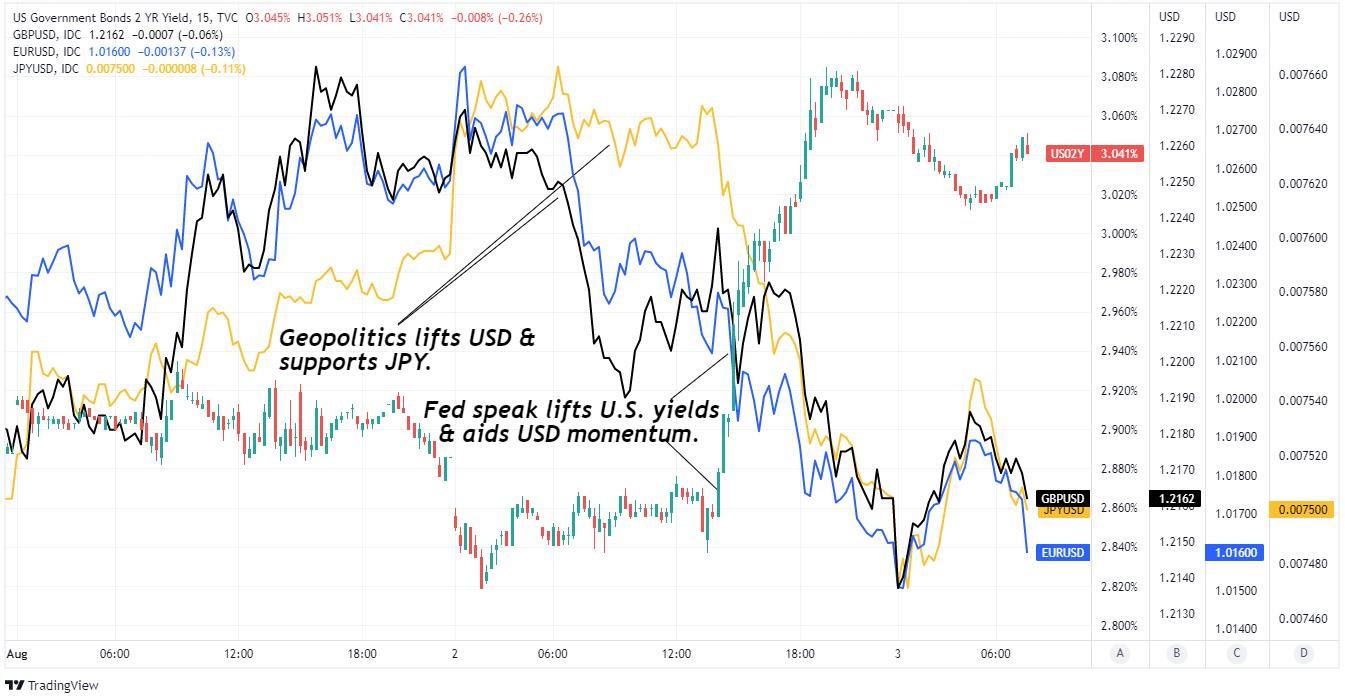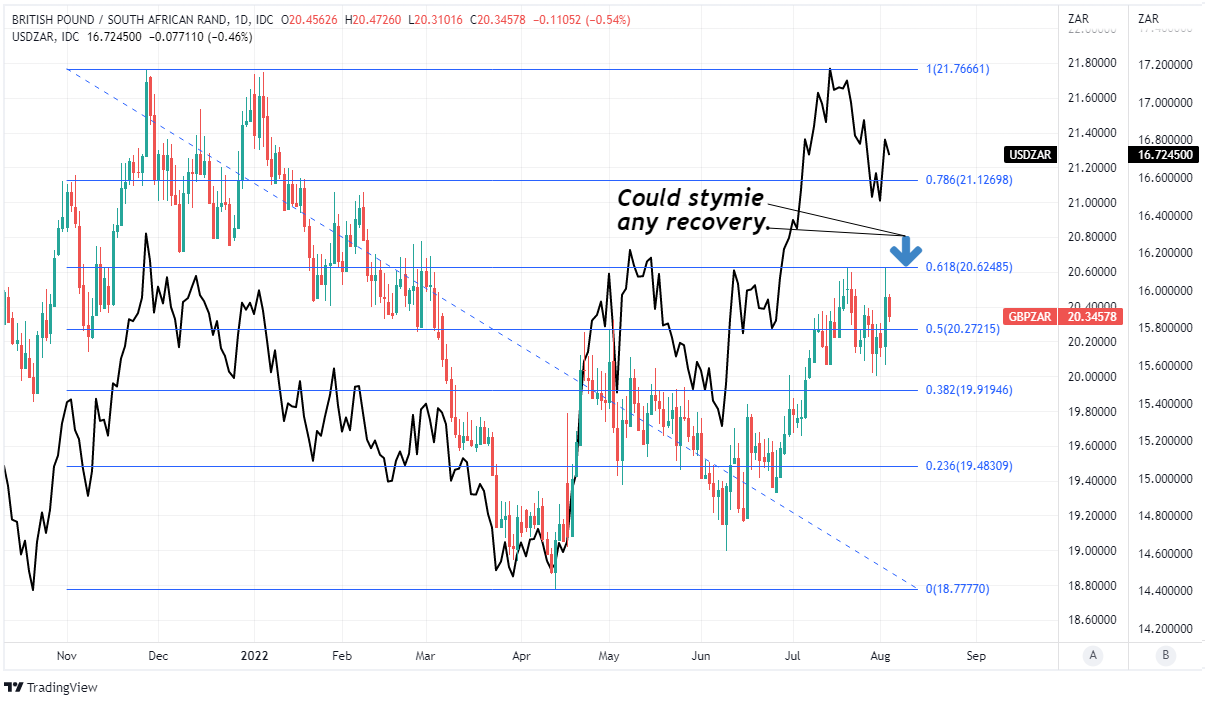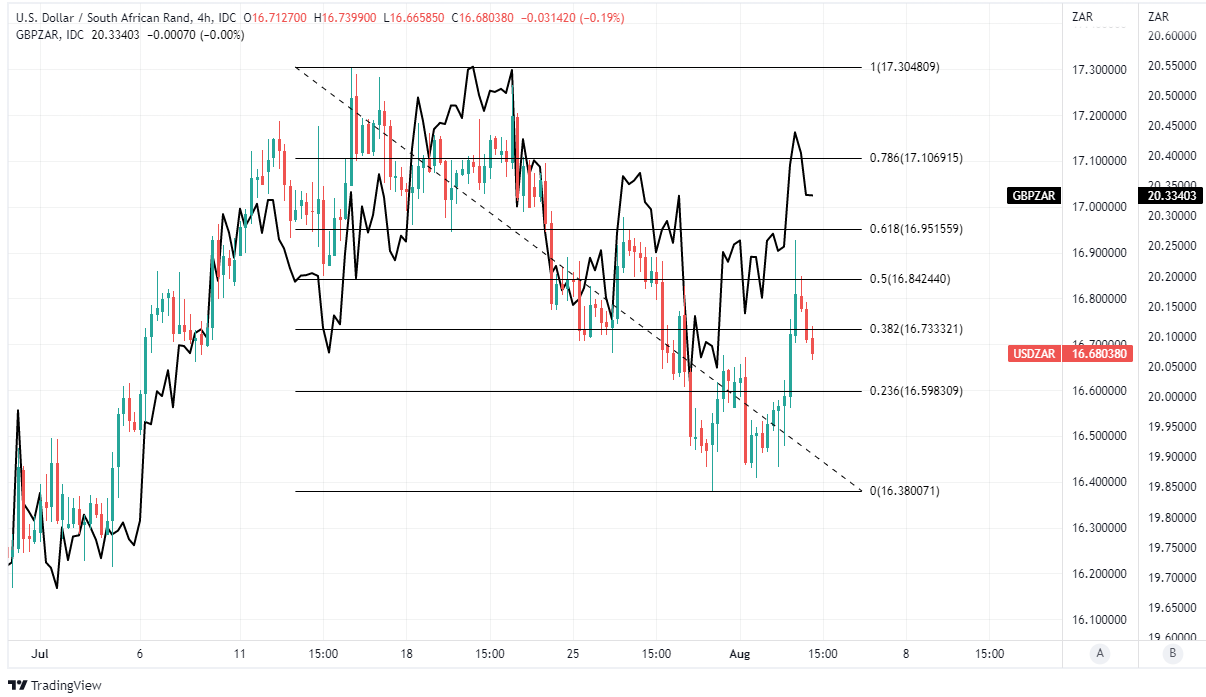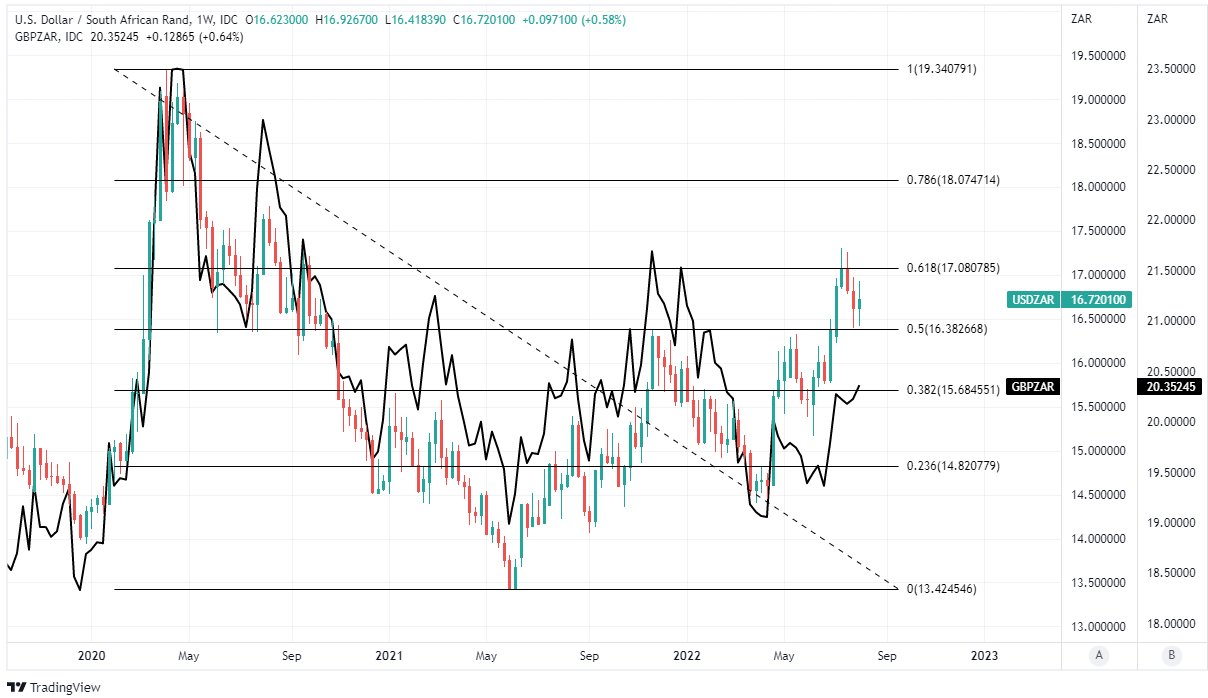Pound to Rand Rate Road Blocked by Resistance Near 20.6248 on Charts
- Written by: James Skinner
- GBP/ZAR near 5-month highs & struggling for momentum
- Technical resistance near 20.6248 obstructing path higher
- After Fed policy chatter, market risk aversion lift USD/ZAR
- Quiet week for SA leaves U.S. economic calendar in focus

Image © Adobe Images
The Pound to Rand exchange rate rose to five month highs during the opening half of the week but lost momentum upon contact with an emerging layer of technical resistance around 20.6248 on the charts, which could continue to obstruct Sterling’s path higher in the days ahead.
South Africa’s Rand made a choppy start to the week alongside many other currencies having come under pressure from a rebounding Dollar in price action that lifted USD/ZAR, GBP/ZAR and other similar exchange rates during the Tuesday session.
“The overnight session saw the USD strengthen significantly across the board as the Fed speakers showed support for a continuation of the aggressive hiking cycle to help curb high inflation,” says Walter de Wet, a fixed income and currency strategist at Nedbank.
“SAGBs [South African government bonds] closed off their best levels, but the weakness into the close was more to do with a retracement in UST and European sovereign yields rather than escalating geopolitical tensions between the US and China,” de Wet said on Wednesday.
 Above: 02-year U.S. government bond yield at hourly intervals with Sterling, Yen and Euro. Click image for closer inspection.
Above: 02-year U.S. government bond yield at hourly intervals with Sterling, Yen and Euro. Click image for closer inspection.
Risk appetite was dampened and many asset prices undermined early in the new week amid an intense market focus on geopolitical developments in the Asia Pacific but the Dollar’s rally bolstered notably by a recovery in U.S. government bond yields.
This was after four members of the Federal Open Market Committee (FOMC) appeared to ward financial markets away from the recently popular assumption that the Federal Reserve’s (Fed) interest rate cycle could be nearing an end.
“We need to keep committed until we actually see it in the data and we are seeing signs that again the economy is slowing but we have a couple more inflation releases before the next FOMC meeting,” San Francisco Federal Reserve President Mary Daly told CNBC on Tuesday.
“We have a couple more labour market reports including one this Friday and I really am looking to see what those data tell us about whether we can downshift a little bit about the pace of rate hikes,” Daly told CNBC News' Jon Fortt.
Of all remarks made by Fed policymakers on Tuesday, those coming from the San Francisco Fed’s Mary Daly may have been the most significant given that she threw cold water all over the market’s recent assumption that the Fed could begin cutting interest rates next year.
 Above: Pound to Rand rate shown at daily intervals alongside USD/ZAR and with Fibonacci retracements of 2022 downtrend indicating possible areas of technical resistance for Sterling. Click image for closer inspection.
Above: Pound to Rand rate shown at daily intervals alongside USD/ZAR and with Fibonacci retracements of 2022 downtrend indicating possible areas of technical resistance for Sterling. Click image for closer inspection.
“It's also really important to continue to fight back on this inflation that we've seen and doing that requires raising and leaving the interest rate for a while,” she also said in remarks that make risky business out of the market’s bet that U.S. interest rates could fall as soon as the early months of 2023.
Mary Daly’s comments are most notable because she will be a voter on the FOMC next year and so will help set the Fed’s interest rate policy in 2023.
One risk to the Rand, Sterling and others is that further commentary from Fed policymakers could force financial markets to reprice the outlook for U.S. interest rates, which is something that would have scope to lift the U.S. Dollar sharply and against many currencies.
Overnight indexed swap contract rates have for some weeks suggested that investors are expecting the Fed’s interest rate to begin falling from May 2023.
But it remains to be seen whether that repricing will take place and there is also uncertainty over if this would be enough to lift the Pound to Rand rate above the 20.6248 level of resistance, which has road blocked Sterling’s path higher on two occasions in the last month.
 Above: USD/ZAR shown at 4-hour intervals alongside GBP/ZAR and with Fibonacci retracements of mid-July fall indicating possible areas of short-term technical resistance for U.S. Dollar. Click image for closer inspection.
Above: USD/ZAR shown at 4-hour intervals alongside GBP/ZAR and with Fibonacci retracements of mid-July fall indicating possible areas of short-term technical resistance for U.S. Dollar. Click image for closer inspection.
“The rand will remain heavily dependent on the global market environment,” says Annabel Bishop, chief economist at Investec.
“With the monetary authorities having frontloaded the interest rate hikes into mainly H1.22 and July this year, the expectation is for a reduction in demand for commodities this year, which is quelling their prices, and will aid the expected moderation in inflation,” Bishop said on Tuesday.
There is little by way of major economic reports in the calendar for South Africa this week but the Rand, Sterling and other currencies will likely be highly sensitive to the messages and implications of the raft of important economic figures due out from the U.S. in the days ahead.
"For today's session, the bigger focus may come on the announcement of fresh supply quotas from OPEC+. So far President Biden's recent trip to Saudi Arabia has yet to produce significant supply increases. Most analysts think the OPEC+ quota for September will be left unchanged," says Chris Turner, global head of markets and regional head of research for UK & CEE at ING.
Friday’s non-farm payrolls report will provide important insights into how the U.S. job market held up after the economy contracted during the second quarter
 Above: USD/ZAR shown at weekly intervals alongside GBP/ZAR and with Fibonacci retracements of the 2020 downtrend indicating possible areas of technical resistance for U.S. Dollar. Click image for closer inspection.
Above: USD/ZAR shown at weekly intervals alongside GBP/ZAR and with Fibonacci retracements of the 2020 downtrend indicating possible areas of technical resistance for U.S. Dollar. Click image for closer inspection.
However, and before then financial markets will likely scrutinise the Institute for Supply Management (ISM) Services PMI survey closely for clues about the condition of the U.S. economy’s largest and most important sector in July.
“Arguing why investors should buy USD has become a little harder with the market pricing in 75bp in rate cuts next year and prices paid in the ISM falling hard,” says Jordan Rochester, an FX strategist at Nomura, who recently advocated that institutional clients buy the U.S. Dollar and Japanese Yen.
Forthcoming data will follow behind Monday’s release of the ISM Manufacturing PMI, which suggested that inflation pressures within the sector moderated at a rapid pace in July after the prices subcomponent of the barometer fell to its lowest level since September 2020.
Meanwhile, and along the way, Pound Sterling and GBP/ZAR could also highly sensitive to the outcome of Thursday’s Bank of England (BoE) policy decision, around which there is much uncertainty.
Financial markets will be most interested in whether the BoE will lift its Bank Rate by a typical quarter percentage point to 1.5% or if it will opt for one of the larger half percentage point increases that have recently been used elsewhere in the world including in South Africa.




